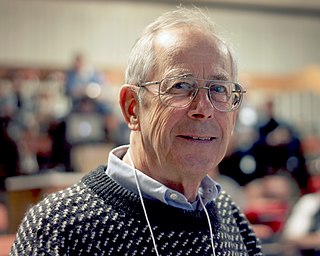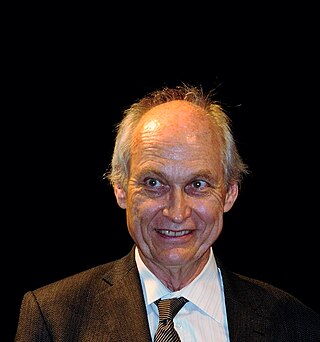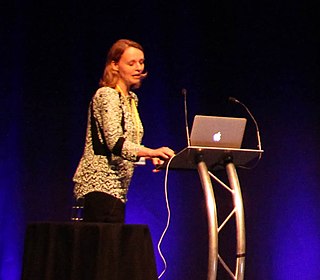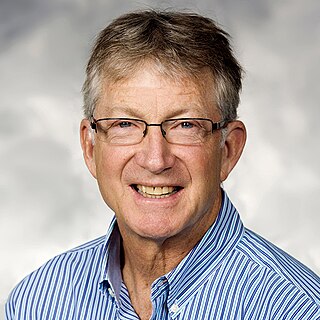Related Research Articles

Phillip James Edwin Peebles is a Canadian-American astrophysicist, astronomer, and theoretical cosmologist who is currently the Albert Einstein Professor in Science, emeritus, at Princeton University. He is widely regarded as one of the world's leading theoretical cosmologists in the period since 1970, with major theoretical contributions to primordial nucleosynthesis, dark matter, the cosmic microwave background, and structure formation.

Michael S. Turner is an American theoretical cosmologist who coined the term dark energy in 1998. He is the Rauner Distinguished Service Professor Emeritus of Physics at the University of Chicago, having previously served as the Bruce V. & Diana M. Rauner Distinguished Service Professor, and as the assistant director for Mathematical and Physical Sciences for the US National Science Foundation.

Curtis Gove Callan Jr. is an American theoretical physicist and the James S. McDonnell Distinguished University Professor of Physics at Princeton University. He has conducted research in gauge theory, string theory, instantons, black holes, strong interactions, and many other topics. He was awarded the Sakurai Prize in 2000 and the Dirac Medal in 2004.

Charles L. Bennett is an American observational astrophysicist. He is a Bloomberg Distinguished Professor, the Alumni Centennial Professor of Physics and Astronomy and a Gilman Scholar at Johns Hopkins University. He is the Principal Investigator of NASA's highly successful Wilkinson Microwave Anisotropy Probe (WMAP).

Marvin Leonard "Murph" Goldberger was an American theoretical physicist and former president of the California Institute of Technology.

Lyman Alexander Page, Jr. is the James S. McDonnell Distinguished University Professor of Physics at Princeton University. He is an expert in observational cosmology and one of the original co-investigators for the Wilkinson Microwave Anisotropy Probe (WMAP) project that made precise observations of the electromagnetic radiation from the Big Bang, known as cosmic background radiation.
Matias Zaldarriaga is a theoretical physicist best known for his work on cosmology. He has made significant contributions toward understanding both astrophysical phenomena and fundamental physics, most notably through his research on modeling the early universe and analyzing statistical properties of cosmic microwave background data. Zaldarriaga grew up in Buenos Aires, Argentina and received his undergraduate degree from the University of Buenos Aires in 1994. He received his PhD in 1998 from the Massachusetts Institute of Technology, followed by a postdoctoral fellowship at the Institute for Advanced Study in Princeton, NJ. Zaldarriaga was a faculty member at New York University and Harvard University, where he received a MacArthur Fellowship in 2006. He is currently a professor at the Institute for Advanced Study, where he has been a faculty member since 2009.
Marc Kamionkowski is an American theoretical physicist and currently the William R. Kenan, Jr. Professor of Physics and Astronomy at Johns Hopkins University. His research interests include particle physics, dark matter, inflation, the cosmic microwave background and gravitational waves.
Robert Hamilton Austin is an American physicist and a professor of physics at Princeton University.
Risa H. Wechsler is an American cosmological physicist, Professor of Physics at Stanford University, and Professor of Particle Physics and Astrophysics at SLAC National Accelerator Laboratory. She is the director of the Kavli Institute for Particle Astrophysics and Cosmology.

Joanna Dunkley is a British astrophysicist and Professor of Physics at Princeton University. She works on the origin of the Universe and the Cosmic microwave background (CMB) using the Atacama Cosmology Telescope, the Simons Observatory and the Large Synoptic Survey Telescope (LSST).

Burçin Mutlu-Pakdil is a Turkish-American astrophysicist, and Assistant Professor at Dartmouth College. She formerly served as a National Science Foundation (NSF) and Kavli Institute for Cosmological Physics (KICP) Postdoctoral Fellow at the University of Chicago. Her research led to a discovery of an extremely rare galaxy with a unique double-ringed elliptical structure, which is now commonly referred to as Burcin's Galaxy. She was also a 2018 TED Fellow, and a 2020 TED Senior Fellow.

Angela Villela Olinto is provost of Columbia University and an astroparticle physicist. Previously, she served as the Albert A. Michelson Distinguished Service Professor at the University of Chicago as well as the dean of the Physical Sciences Division. Her current work is focused on understanding the origin of high-energy cosmic rays, gamma rays, and neutrinos.

Glennys Reynolds Farrar is a professor of physics at New York University who specializes in particle physics, cosmology and the study of dark matter. She has made several significant contributions to the fields of hadron and dark matter phenomenology, helping to develop the working "Standard Cosmological Model". Farrar is a figure in developing many modern particle-search techniques, achieving numerous recognitions including as the Guggenheim Fellowship for Natural Sciences and Sloan Fellowship. She holds a faculty position at New York University (NYU), where she has been since 1998.

James L. Skinner is an American theoretical chemist. He is the Joseph O. and Elizabeth S. Hirschfelder Professor Emeritus at the University Wisconsin-Madison. He is also a member of the Scientific Advisory Board of the Welch Foundation. Most recently, Skinner was the Crown Family Professor of Molecular Engineering, professor of chemistry, director of the Water Research Initiative and deputy dean for faculty affairs of the Pritzker School of Molecular Engineering at the University of Chicago. Skinner is recognized for his contributions to the fields of theoretical chemistry, nonequilibrium statistical mechanics, linear and nonlinear spectroscopy of liquids, amorphous and crystalline solids, surfaces, proteins, and supercritical fluids. Skinner is the co-author of over 230 peer-reviewed research articles.
Arthur Kosowsky is a theoretical physicist and cosmologist, and chair of the Department of Physics and Astronomy at the University of Pittsburgh.
Suzanne Walker is a professor of Microbiology and Molecular Genetics at Harvard University. Her research focuses on mechanisms of antibiotics and antibiotic resistance. She was elected to the National Academy of Sciences in 2020.
Abigail Goodhue Vieregg is a professor of physics at the Enrico Fermi Institute and Kavli Institute of Cosmology, University of Chicago, specializing in neutrino astrophysics and cosmology. Her work focuses on cosmic high-energy neutrinos and mapping the cosmic microwave background.
Joshua A. Frieman is a theoretical astrophysicist who lives and works in the United States. He is a senior scientist at Fermilab and a professor of astronomy and astrophysics at the University of Chicago. Frieman is known for his work studying dark energy and cosmology, and he co-founded the Dark Energy Survey experiment. He was elected a member of the National Academy of Sciences in 2022.
Amber Dawn Miller is an American experimental cosmologist. She is a professor of physics and astronomy at the University of Southern California and the dean of the Dornsife College of Letters, Arts, and Sciences. She is an American Physical Society Fellow.
References
- ↑ "Suzanne Staggs". princeton.edu. Retrieved April 15, 2017.
- ↑ "Award". aps.org. Retrieved April 15, 2017.
- ↑ "Newly Elected Fellows". amacad.org. Retrieved April 15, 2017.
- 1 2 "Suzanne T. Staggs". American Academy of Arts & Sciences. Retrieved 2019-05-23.
- ↑ "Suzanne Staggs | The Princeton Gravity Initiative". gravity.princeton.edu. Retrieved 2019-05-23.
- ↑ "Suzanne Staggs". Princeton University Admission. 2016-09-12. Retrieved 2019-05-23.
- ↑ "2020 NAS Election". www.nasonline.org. Retrieved 2020-10-04.
- 1 2 3 4 5 "2018 Stanley Corrsin Award Recipient". www.aps.org. Retrieved 2019-05-23.
- ↑ "KICP People | Suzanne Staggs". kicp.uchicago.edu. Retrieved 2019-05-23.
- 1 2 3 4 5 "Suzanne Staggs". World Science Festival. Retrieved 2019-05-23.
- ↑ "Suzanne T. Staggs". American Academy of Arts & Sciences. Retrieved 2020-05-10.
- ↑ "2020 NAS Election". www.nasonline.org. Retrieved 2020-05-10.
- 1 2 "Biography" (PDF).
- ↑ "Past Fellows". sloan.org. Retrieved 2019-05-23.
- ↑ "Fellowship Recipients | The Enrico Fermi Institute | The University of Chicago". efi.uchicago.edu. Retrieved 2019-05-23.